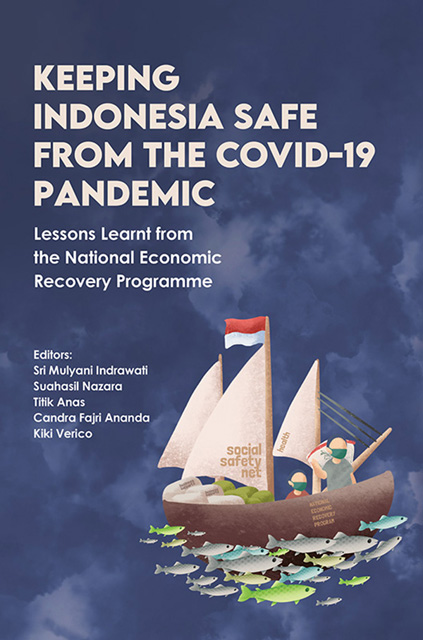 Keeping Indonesia Safe from the COVID-19 Pandemic
Keeping Indonesia Safe from the COVID-19 Pandemic Book contents
- Frontmatter
- Contents
- List of Figures
- List of Tables
- List of Boxes, Annexes and Appendixes
- Acknowledgements
- Glossary
- The Contributors
- Foreword: Keeping Indonesia Safe from the COVID-19 Pandemic Lessons Learnt from the National Economic Recovery Programme
- Part I Health Shock
- Part II Economic Shock: The Framework
- Part III Revenue Shock And Response
- Part IV Expenditure Side (Human Capital)
- Part V Expenditure Side (Msmes And Corporate Sector)
- Part VI Regional Dynamics
- Part VII New Ways Of Working
- Index
4 - Financial Sector and Monetary Policy during the Pandemic
Published online by Cambridge University Press: 30 June 2023
- Frontmatter
- Contents
- List of Figures
- List of Tables
- List of Boxes, Annexes and Appendixes
- Acknowledgements
- Glossary
- The Contributors
- Foreword: Keeping Indonesia Safe from the COVID-19 Pandemic Lessons Learnt from the National Economic Recovery Programme
- Part I Health Shock
- Part II Economic Shock: The Framework
- Part III Revenue Shock And Response
- Part IV Expenditure Side (Human Capital)
- Part V Expenditure Side (Msmes And Corporate Sector)
- Part VI Regional Dynamics
- Part VII New Ways Of Working
- Index
Summary
PRE-PANDEMIC INDONESIAN BANKING SECTOR: STRONG CAPITAL AND LOW RISK
Before the pandemic, Indonesia's banking sector performed positively, in line with the economic growth in the past few years. Having been through a few big economic crises, i.e., the Asian Financial Crisis (1997–98) and the Global Financial Crisis (2008), Indonesia's banking sector has come a long way and has continued to implement good governance and prudent risk management practices. Up to this day, the banking sector remains the most regulated industry in Indonesia as it is the backbone of the financial sector.
Over the years leading to the pandemic-led crisis, Indonesia's banking sector proved to be resilient and withstood episodes of economic slowdown with strong capital, sufficient liquidity and low credit risk. The banking sector's capital adequacy ratio was relatively stable at 23 per cent by the end of 2019 (Table 4.1). Credit risk was relatively low, as the non-performing loans (NPLs) remained below 3 per cent in the pre-pandemic years. Yet, credit growth had started a notable slowdown. By the end of 2019, credit recorded 6 per cent growth, declining from as high as 13 per cent in 2018 (Figure 4.1). Furthermore, banks’ liquidity was slightly tighter, as the loanto- deposit ratio was at 93.6 per cent by the end of 2019.
Credit growth generally moves in line with the pace of economic growth. During the commodity boom, the banking sector recorded strong growth. Credit disbursement managed to reach double-digit growth due to rising economic activities related to and/or derived from the commodity sectors. In 2010–13, credit growth recorded 20–25 per cent growth. Unfortunately, following the slowdown of China's economy, commodity prices started declining, which soon marked the end of Indonesia's commodity boom.
Since 2016, credit growth has continued to decelerate to <10 per cent, which gives an indication of the significance of commodity sectors to the economy. The unfavourable global environment at the time—with rising geopolitical tensions between the US and China, which led to a trade war— had brought negative effects on global growth and then reduced global demand for commodities. The slowdown in credit was also shown by a continuously lowering loan growth to nominal GDP growth ratio in the last four to five years.
- Type
- Chapter
- Information
- Keeping Indonesia Safe from the COVID-19 PandemicLessons Learnt from the National Economic Recovery Programme, pp. 106 - 146Publisher: ISEAS–Yusof Ishak InstitutePrint publication year: 2022


